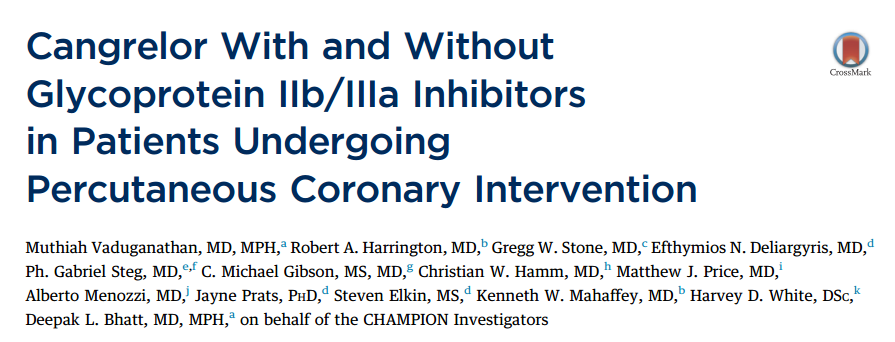A new pubblication about Cangrelor With and Without Glycoprotein IIb/IIIa Inhibitors in Patients Undergoing Percutaneous Coronary Intervention has been published on JACC.
BACKGROUND
Cangrelor, an intravenous, reversible P2Y12 antagonist, is approved for use in patients undergoing percutaneous coronary intervention (PCI).
OBJECTIVES This study sought to evaluate the efficacy and safety of cangrelor compared with clopidogrel in subgroups that did and did not receive glycoprotein IIb/IIIa inhibitors (GPIs).
METHODS This pooled, patient-level analysis of the 3 CHAMPION (Cangrelor versus Standard Therapy to Achieve Optimal Management of Platelet Inhibition) trials analyzed all randomized patients who underwent PCI and received the study drug (n ¼ 24,902). Only bailout/rescue GPI use was permitted, except in CHAMPION PCI, in which routine or bailout/rescue GPI use was at the site investigator’s discretion. The primary efficacy endpoint was the composite of all-cause mortality, myocardial infarction, ischemia-driven revascularization, or stent thrombosis at 48 h after randomization.
RESULTS
Overall, 3,173 patients (12.7%) received a GPI, most commonly eptifibatide (69.4%). Despite variation in indications for GPIs, baseline characteristics were well balanced between the cangrelor and clopidogrel arms in subsets receiving and not receiving GPIs. Rates of the primary composite endpoint were lower with cangrelor compared with clopidogrel in patients who did (4.9% vs. 6.5%; odds ratio [OR]: 0.74; 95% confidence interval [CI]: 0.55 to 1.01) or did not receive a GPI (3.6% vs. 4.4%; OR: 0.82; 95% CI: 0.72 to 0.94; Pint ¼ 0.55). Cangrelor did not increase the primary safety endpoint, GUSTO-defined severe/life-threatening bleeding, in patients who did (0.4% vs. 0.5%; OR: 0.71; 95% CI: 0.25 to 1.99) or did not receive GPIs (0.2% vs. 0.1%; OR: 1.56; 95% CI: 0.80 to 3.04; Pint ¼ 0.21). GPI use was associated with increased risk of bleeding in both treatment arms.
CONCLUSIONS
Cangrelor’s efficacy in reducing ischemic complications in patients undergoing PCI was maintained irrespective of GPI administration. GPI use was associated with substantially higher bleeding rates, regardless of the randomization to cangrelor or clopidogrel. (A Clinical Trial to Demonstrate the Efficacy of Cangrelor [PCI]: NCT00305162; Cangrelor Versus Standard Therapy to Achieve Optimal Management of Platelet Inhibition [PLATFORM]: NCT00385138; A Clinical Trial Comparing Cangrelor to Clopidogrel Standard Therapy in Subjects Who Require Percutaneous Coronary
Intervention [PCI] [CHAMPION PHOENIX] [CHAMPION]: NCT01156571) (J Am Coll Cardiol 2017;69:176–85)
© 2017 by the American College of Cardiology Foundation.
Here is the full article:
8 Cangrelor without GPI JACC 17



